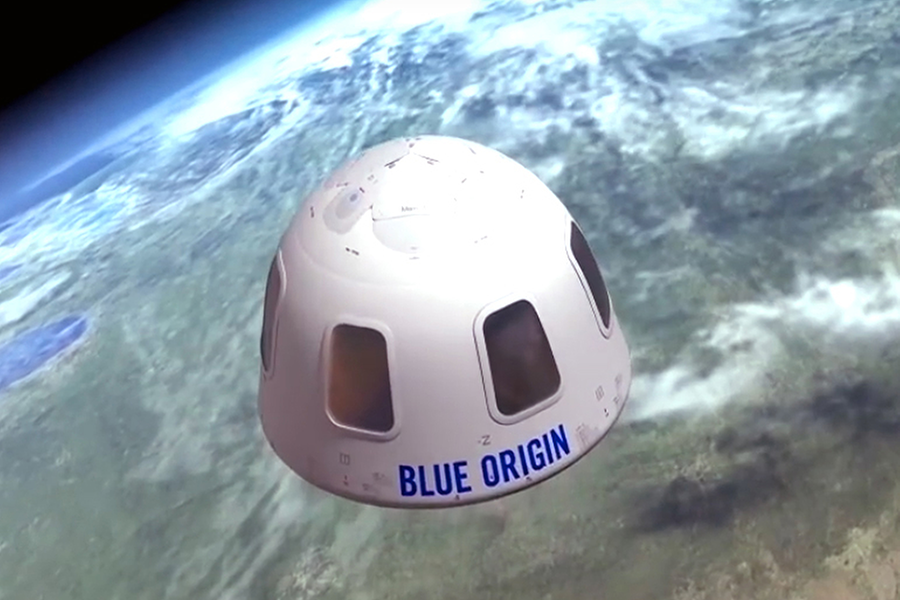Blue Origin offers window into what a space vacation might look like, literally
Loading...
Blue Origin, the private spaceflight company created by Amazon founder Jeff Bezos, has released photos of the interior of its New Shepard spacecraft, which Mr. Bezos hopes will bring tourists into space as early as 2018.
The New Shepard, named after the first American in space, Alan Shepard, has already been successfully launched and landed five times in uncrewed test flights. Blue Origin intends for the capsule to eventually be used to take passengers to the frontier of space, allowing them to experience weightlessness and enjoy the view of their home planet more than 100 kilometers (62 miles) below them.
“Every seat’s a window seat, the largest windows ever in space,” Bezos wrote in an email update about the spacecraft, according to The Verge.
The new images reveal a sleek, futuristic 530-cubic-foot interior with six seats. In the center of the cabin is a capsule that houses an escape motor designed to kick in in the event of an emergency at launch, pushing the passengers away from an exploding booster engine.
“Our New Shepard flight test program is focused on demonstrating the performance and robustness of the system,” Bezos said in the email release. “In parallel, we’ve been designing the capsule interior with an eye toward precision engineering, safety, and comfort.”
The new photos are a tantalizing glimpse at the futuristic world of commercial space travel, often touted by companies like Blue Origin and SpaceX as inevitable. But while space tourism has captured the public imagination since before the first manned rockets took off from Earth’s surface in the 20th century, that future has faced delays recently, despite assurances that regular space tourism is not far off. As The Christian Science Monitor’s Eva Botkin-Kowacki reported in February:
Two private citizens have booked a trip around the moon scheduled for 2018, according to a SpaceX announcement Monday afternoon.
Yes, you read that right. The commercial spaceflight company that has yet to fly any crewed missions into space plans to send two non-astronauts beyond Earth's orbit next year. Is that really possible?
"My guess is that 2020 is more realistic," Jonathan McDowell, an astrophysicist at the Harvard-Smithsonian Center for Astrophysics, says in a phone interview with The Christian Science Monitor....
This criticism came after one of SpaceX's semi-reusable rockets exploded during a routine test. [Scott Pace, a former NASA official and director of the Space Policy Institute at George Washington University] expressed concern that people working for the company might be run ragged by the demands, leading to human errors.
That's a significant concern when talking about sending millions of dollars of equipment up to the International Space Station, but the stakes become much higher with humans, especially non-astronaut humans, on board.
But despite delays and the necessity for further safety testing, both SpaceX and Blue Origin have been moving forward with their ambitious space tourism projects. The latter has already announced plans for the next generation of spacecraft after New Shepard: New Glenn, which the company is already considering selling tickets for, despite the design still being in development.
Blue Origin is also focusing on another money-maker, ferrying satellites into orbit for commercial companies, a common strategy for corporate entities breaking into private space flight. Blue Origin was recently contracted by French telecom firm Eutelsat to send a communications satellite into orbit on its New Glenn rocket, scheduled for completion in 2020. But until then, Blue Origin continues to paint a dramatic picture of what that future commercial trip into space could look like, distant or not:
“Sitting atop a 60-foot-tall rocket in a capsule designed for six people, you’ll feel the engine ignite and rumble under you as you climb through the atmosphere,” proclaims the company’s official site. “Accelerating at more than 3 Gs to faster than Mach 3, you will count yourself as one of the few who have gone these speeds and crossed into space.”








